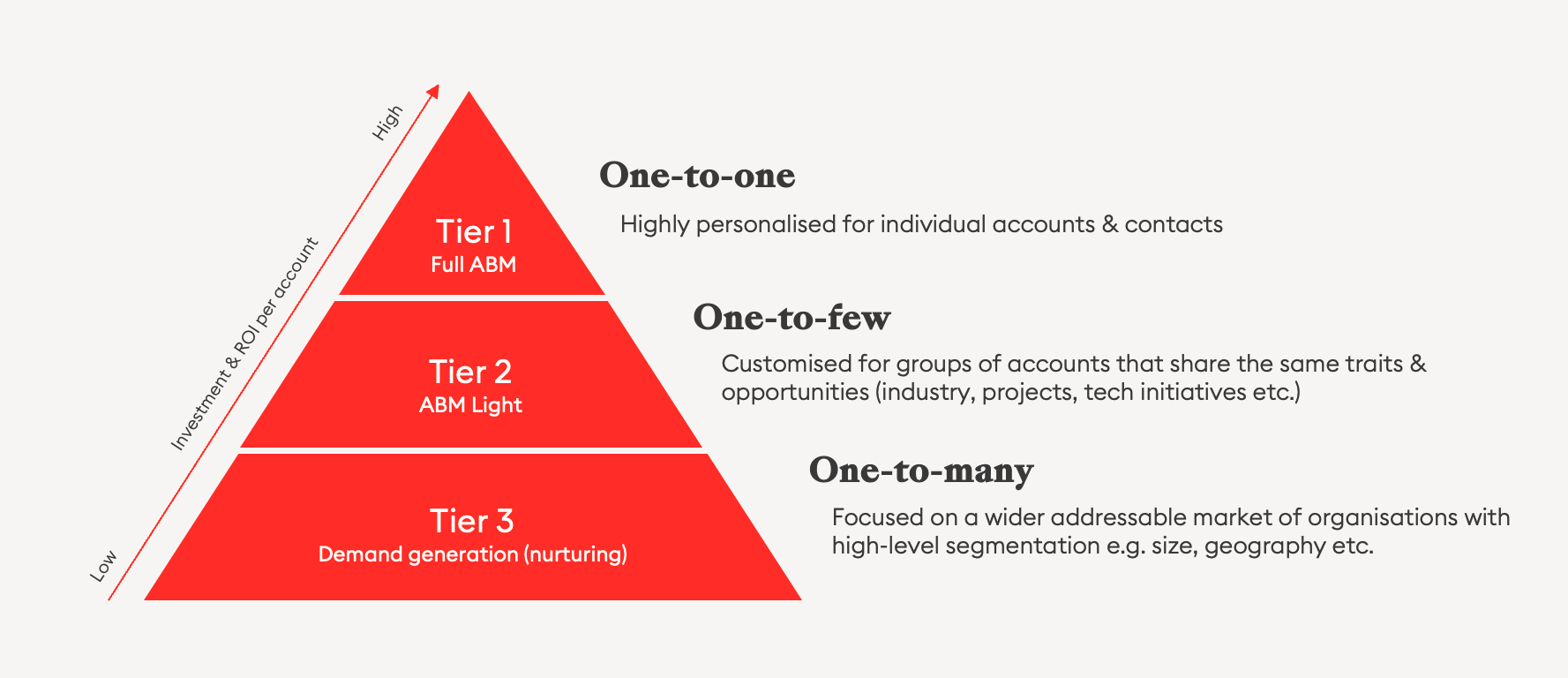Alignment: Why marketing needs sales, more than sales needs marketing

The lack of alignment between marketing and sales teams in B2B is nothing new. But when it happens, it puts a great big spanner in an organisation’s ability to grow revenue. There has been an air of inevitability that this issue would come back around. Here's our take on why.
>>>
B2B marketers have made huge strides in recent years, due to our ability to demonstrate a return on investment. But now questions are being asked because results aren't what they used to be. We've been rumbled by audiences who now want to remain anonymous.
You know the drill. Create content, gate it behind a form, follow-up any prospects who submit and convert these Marketing Qualified Leads (MQLs) into real sales opportunities. The problem is buyers also know the drill, and will do everything they can to avoid being snared.
Sales have also been finding it more and more difficult to prospect too. It means that both teams are having to grind it out, working harder and harder in their respective pipeline generation sweatshops, only to see dwindling results. Naturally, frustrations boil to the surface, which is exactly when the two teams need to work with, not against, each other.
What’s interesting is that the marketing community is far more vocal about the need for alignment, than its counterparts in sales. Like a 'complaint' of Karen’s, it tends to be marketers who bitch about sales - when their efforts don’t translate into pipeline. Normally, it means whinging about a lack of follow-up or sales being off-message.
On the flip side, it’s actually a little humiliating that salespeople rarely bemoan the lack of alignment with marketing. It's just not a topic that's ever really covered in the most prominent sales journals. The one thing we did find was a piece from leading B2B sales guru, Bob Apollo, who wrote an article called, ‘Why salespeople don’t care about marketing alignment - but they ought to’. Which kind of sums it up.
Savvy salespeople do value marketing
In our experience, smart salespeople do value what marketing can bring, they just don't really have any interest in a formal alignment initiative. Most successful salespeople are very selfish with their time. That's just a fact.
Nevertheless, they do want the support of marketing, but maybe not for the reasons you think. Often lead generation is secondary to the advantages created through jointly-targeted prospects, who’ve grown to know and trust your brand.
If a salesperson finds themselves in any scenario with a qualified prospect who knows all about the salesperson’s business - and has an affinity for their brand - the sales process will be much easier. This is far more compelling than a list of 50 raw leads.
Other areas that sales value from marketing are insights into target accounts, an understanding of account engagement and content that aids the sales process - such as relevant case studies. They really value the investment in marketing their business is prepared to make, if it’s invested in the right areas.
Perversely, marketers and business leaders find all of this uncomfortable. It is so much more difficult to track and measure the things that salespeople value most. Instead, marketing needs to be firmly on the hook for something. And with MQLs, at least there is an actual KPI on which marketing can be held to account.

So is the problem marketing, not sales?
That’s easy - yes. The alignment problem is largely down to marketing, not sales. However, the explanation needs a bit of breaking down.
Misalignment is exacerbated by marketers who believe all leads are the same. They focus on reporting the quantity of leads - for example, they celebrate the 50 plus MQLs who’ve registered for a webinar. Then they think it’s over to sales to convert them.
Salespeople on the other hand are focused at the other end of the pipeline. A good salesperson will get out of bed in the morning and focus on the deal that is most likely to close next. Then they work back from there.
Sure, they will be concerned about ensuring they have enough in the pipeline to have the right amount of opportunities to meet their quota. But they will spend more time and effort on closing deals, not early-stage prospecting.
What precious time salespeople have left for pipeline development will be spent on activities they feel are more likely to generate better, more immediate opportunities. Pushing partners or customers for referrals, sourcing RFPs, leveraging existing relationships in their network and so on.
So, the problem is clear to see.
Salespeople don't like MQLs
MQLs are far less attractive to salespeople because they are not all created equal. Every ‘lead’ will be at a different stage when they first engage. Some may be too late as they are about to appoint a new partner, some will be too early and have no plans to buy right now. And the rest will be somewhere in between.
This doesn’t mean the leads aren’t necessarily good or bad. Neither marketer or sales person can really affect the situation of each lead at the point of first engagement. But in a business where short-term thinking prevails, sales will only want those leads that are ready to buy now.
So then a huge fucking chasm emerges, because the 50 MQLs don’t get followed-up, and much of the marketing effort is wasted. The reason for this is that every lead must be qualified to understand the stage they are at. From 50 webinar MQLs, there’s likely to be at least a handful worth pursuing. But you won’t know which ones until they are properly spoken to i.e. qualified.
Understandably, the sales team (who are laser-focused on closing today's deals), just won’t have the time or inclination to persist with all of them.
How to improve sales and marketing collaboration
The first thing to acknowledge is that marketing needs sales, more than sales needs marketing. So it’s up to us marketers to extend the olive branch. There’s a number of key things marketing can make happen for collaboration to start working more effectively, as follows:
-
Tying together KPIs: Marketing and sales teams should align their key performance indicators (KPIs) and incentives. This means having a shared goal of revenue generation, but then breaking down the elements of the process that each function can impact to drive revenue. Marketing KPIs should be set on things further down the sales process, such as pipeline contribution, influenced pipeline and key account engagement, while sales KPIs remain as closed deals and performance against quota.
-
Collective targeting: LinkedIn data shows there is only a 23% overlap between the audiences that sales and marketing teams go after. Sorry, but that’s fucking nuts! Marketing needs to work with sales to build a unified list of target organisations and ensure all efforts from both functions are solely focused on the same set of accounts. Sales will benefit from their targets being more regularly exposed to the brand, rather than receiving random MQLs that may not be a fit.
NB: Tiering accounts will help the collective targeting process, as shown below.

- Building brand engagement: Further to the last point, when the sales team has a clearer idea of the accounts who are engaging most and with what, they can prioritise those accounts. Targeted ads, focused thought leadership and personalised messages are going to be more effective when deployed on a select number of unified accounts. They will also more likely respond to sales outreach if familiarity with the brand exists.
- Establishing the BDR function: The critical role of a Business Development Representative (BDR) is arguably the best way to bridge the gap between marketing and sales. BDRs work closely with both teams, qualifying and nurturing leads generated by marketing before handing them-off to sales representatives. This dedicated role acts as the glue between both functions and improves the effectiveness of both teams' efforts. You may struggle to grow pipeline without it.
- Moving to a single customer platform: Adopting a unified customer tech platform with a single, centralised dataset used by both marketing and sales will significantly improve collaboration. By having a single source of truth, both teams can access the same information, track engagements, and gain a comprehensive understanding of a prospects situation, needs and priorities.
- Sharing account-level data and insight: Sales teams often possess valuable insights into customer needs, pain points, and buying behaviours based on their direct interactions. Sharing this account-level data and intelligence with marketing can help refine targeting, messaging, and content strategies, leading to more effective campaigns and better-qualified leads.
- Implementing sales enablement: Sales enablement involves equipping the sales and BDR teams with the necessary data, tools, resources, and training to maximise their engagement with prospects. Marketing plays a crucial role in this by providing up-to-date accurate account and contact data, collateral, presentations, case studies, and other materials that align with the company's value proposition. But this cannot be done in a marketing silo.
Marketing will always need sales to be successful
The central argument of this blog is that marketing needs sales, more than sales needs marketing. Marketing cannot demonstrate its true impact on revenue if the opportunities it has helped generate are never closed by the sales team. However, a self-generating sales team can be successful without marketing.
This might be an unpopular opinion, but it’s up to marketing to stop operating in a silo and do everything it can to collaborate better with the sales function. There’s never been a better time to do this, as salespeople need help in two key areas. Firstly, they want their prospects to be more brand aware. Secondly, they find it increasingly difficult to self-generate, so would welcome more quality in the pipeline. Pull these levers, and you’ll be banging on an open door.
Ultimately, the most effective sales and marketing functions act as one team, with the shared goal of growing revenue for their business. But they also have a long-term outlook, being happy to nurture all leads - rather than a short-term mindset, focused only on prospects who may buy today.



